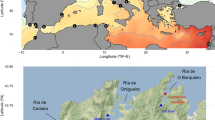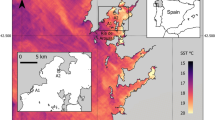Abstract
The pedunculated cirripedePollicipes pollicipes is of considerable economic importance in Portugal, particularly along the southwest coast. Current knowledge of its biology is poor, as evidenced by the paucity of available literature. This paper reports on the reproduction of twoP. pollicipes populations, Castelejo and Zavial, on the southwest coast of the Algarve. Differences in reproductive patterns between the two sites were minor and not statistically significant, despite differences in environmental conditions between the two sites. Adult animals carried fertilised eggs from April throughout September, and the percentage of individuals with egg masses correlated positively with air but not with sea water temperature. Brooding success was greater with average air temperature in excess of 14°C during months of strong upwelling and presumed food availability. Functional ovaries and testes are available in the population all year round but fertilisation does not appear to occur during the winter months. Reproduction ofP. pollicipes on the southwest coast of the Algarve appears closely linked to the upwelling phenomenon with the rate of deposition of gonadal tissue probably being determined by environmental temperature. The cues which determine the cessation of fertilisation remain to be investigated.
Similar content being viewed by others
References
AZEVEDO, C. and L. CORRAL, 1982. Ultrastructural study of spermatozoon and spermiogenesis ofPollicipes cornucopia (Crustacea; Cirripedia), with special reference to the nucleus maturation. J. Submicrosc., 14: 641–654.
BARNES, M., 1992. The reproductive periods and condition of the penis in several species of common cirripedes. Oceanogr. Mar. Biol. Annu. Rev., 30: 483–525.
BARNES, H. and M. BARNES, 1968. Egg numbers, metabolic efficiency of egg production and fecundity: local and regional variations in a number of common cirripedes. J. Exp. Mar. Biol. Ecol., 2: 135–153.
BARNES, H., M. BARNES and W. KLEPAL, 1977. Studies on the reproduction of cirripedes. I. Introduction: copulation, release of oocytes and formation of egg lamellae. J. Exp. Mar. Biol. Ecol., 27: 195–218.
BERNARD, F.R., 1988. Potential fishery for the gooseneck barnaclePollicipes polymerus (Sowerby, 1833) in British Columbia. Fish. Res., 6: 287–298.
BERTNESS, M.D., GAINES, S.D., BERMUDEZ, D. and E. SANFORD, 1991. Extreme spatial variation in the growth and reproductive output of the acorn barnacleSemibalanus balanoides. Mar. Ecol. Prog. Ser., 75: 91–100
CARVALHO, F., 1983. Estudo preliminar sobre o ciclo reprodutivo do percebe (Pollicipes cornucopia Leach) (Crustacea; Cirripedia) na costa Norte de Portugal. Seminar, sobre Aquacult. INIP/APRH.
CIMBERG, R.L., 1981. Variability in brooding activity in the stalked barnaclePollicipes polymerus. Biol. Bull., 160: 31–42.
CRUZ, T., 1993. Growth ofPollicipes pollicipes (Gmelin, 1790) (Cirripedia, Lepadomorpha) on the SW coast of Portugal. Crustaceana, 65(2): 151–158.
CRISP, D.J., 1954. The breeding ofBalanus porcatus (Da Costa) in the Irish Sea. J. Mar. Biol. Ass. UK., 33: 473–496
CRISP, D.J. and P.A. DAVIES, 1955. Observations in vivo on the breeding ofElminius modestus grown on glass slides. J. Mar. Biol. Ass. UK., 34: 357–380
GOLDBERG, H., 1984. Possibilidades de cultivo de Percebe,Pollicipes cornucopie Leach, en sistemas flotantes. Inf. Tec. Inst. Esp. Oceanogr., 19: 1–13.
HILGARD, G.H., 1960. A study of reproduction in the intertidal barnacleMitella polymerus, in Monterey Bay, California. Biol. Bull., 119: 169–188.
HINES, A.H., 1978. Reproduction in three species of intertidal barnacles from central California. Biol. Bull., 154: 262–281.
LEWIS, C.A., 1975. Development of the gooseneck barnaclePollicipes polymerus (Cirripedia: Lepadomorpha): fertilization through settlement. Mar. Biol., 32: 141–153.
LEWIS, C.A. and F.-S. CHIA, 1981. Growth, fecundity, and reproductive biology in the pedunculate cirripedePollicipes polymerus at San Juan Island, Washington. Can. J. Zool., 59: 893–901.
MOLARES, J., TILVES, F. and C. PASCUAL, 1994. Larval development of the pedunculate barnaclePollicipes cornucopia (Cirripedia: Scalpellomorpha) reared in the laboratory. Mar. Biol., 120: 261–264.
PAGE, H.M., 1984. Local variation in reproductive patterns of two species of intertidal barnacles,Pollicipes polymerus Sowerby andChthamalus fissus Darwin. J. Exp. Mar. Biol. Ecol., 74: 259–272.
Author information
Authors and Affiliations
Rights and permissions
About this article
Cite this article
Cardoso, A.C., Yule, A.B. Aspects of the reproductive biology ofPollicipes pollicipes (Cirripedia; Lepadomorpha) from the southwest coast of Portugal. Netherlands Journal of Aquatic Ecology 29, 391–396 (1995). https://doi.org/10.1007/BF02084238
Issue Date:
DOI: https://doi.org/10.1007/BF02084238




